September
23, 1989
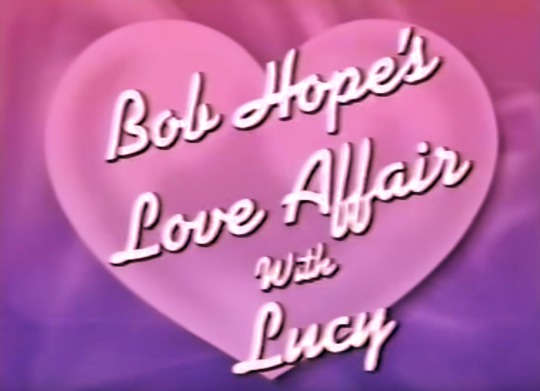
Produced
& Directed by Ellen Brown
Written
by Robert L. Mills, Martha Bolton, Jeffrey Barron
Lucille
Ball (Archival
Footage) was born on August 6, 1911 in Jamestown, New York. She began
her screen career in 1933 and was known in Hollywood as ‘Queen of
the B’s’ due to her many appearances in ‘B’ movies. With
Richard Denning, she starred in a radio program titled “My Favorite
Husband” which eventually led to the creation of “I Love Lucy,”
a television situation comedy in which she co-starred with her
real-life husband, Latin bandleader Desi Arnaz. The program was
phenomenally successful, allowing the couple to purchase what was
once RKO Studios, re-naming it Desilu. When the show ended in 1960
(in an hour-long format known as “The Lucy-Desi Comedy Hour”) so
did Lucy and Desi’s marriage. In 1962, hoping to keep Desilu
financially solvent, Lucy returned to the sitcom format with “The
Lucy Show,” which lasted six seasons. She followed that with a
similar sitcom “Here’s Lucy” co-starring with her real-life
children, Lucie and Desi Jr., as well as Gale Gordon, who had joined
the cast of “The Lucy Show” during season two. Before her death
in April 1989, Lucy made one more attempt at a sitcom with “Life
With Lucy,” also with Gordon, which was not a success and was
canceled after just 13 episodes.
TRIBUTES BY
Bob
Hope
(Himself, Host) was
born Lesley Townes Hope in England in 1903. During his extensive
career in virtually all forms of media he received five honorary
Academy Awards. In 1945 Desi Arnaz was the orchestra leader on Bob
Hope’s radio show. Ball and Hope did four films together. He
appeared as himself on the season
6 opener
of
“I Love Lucy.” He did a brief cameo in a 1964 episode of “The
Lucy Show.”
When
Lucille Ball moved to NBC in 1980, Hope appeared on her welcome
special.
He died in 2003 at age 100.
George
Burns
(Himself) was
born Nathan Birnbaum in New York City in January 1896. He married
Gracie Allen in 1926 and the two formed an act (Burns and Allen) that
toured in vaudeville. They had their own hit show “The George Burns
and Gracie Allen Show” first on radio then on CBS TV from 1950 to
1958, airing concurrently with “I Love Lucy.” He appeared as
himself on “The Lucy Show” (S5;E1) in 1966 as well as doing a
cameo on “Lucy and Jack Benny’s Biography” (HL S3;E11) in 1970.
After Allen’s death in 1964, Burns reinvented himself as a solo
act. In 1976 he won an Oscar for playing one of The
Sunshine Boys.
He was also known for playing the title role in Oh,
God! (1978)
and its 1984 sequel Oh,
God! You Devil.
Burns
and Ball appeared on many TV variety and award shows together. He
died at the age of 100.
Danny
Thomas
(Himself) was
born Amos Muzyad Yakhoob Kairouz in 1912. His screen career began in
1947 but he was most famous for appearing on television in the
long-running show “Make Room for Daddy” (1953-64), which was
shot at Desilu Studios. When the series moved from ABC to CBS in
1957, Thomas and the cast starred in a rare TV cross-over with “The
Lucy-Desi Comedy Hour” titled “Lucy
Makes Room for Danny.”
In
return, Lucy and Desi turned up on Thomas’s
show.
Fifteen years later, Lucy and Danny did yet another cross-over when
Lucy Carter of “Here’s Lucy” appeared on “Make
Room for Granddaddy.”
In
addition, Thomas also played an aging artist on a 1973 episode of
“Here’s
Lucy.”
Thomas
is fondly remembered for founding St. Jude Children’s Research
Hospital. He is also father to actress Marlo Thomas. He died in 1999.
Betty
White
(Herself) was born in 1922 and has the longest career of any female
entertainer. She is probably best known as Rose Nylund on “The
Golden Girls” and Sue Ann Nivens on “The Mary Tyler Moore Show.”
Although White and Ball never acted together, the two appeared
several times on “Password,” one of Lucy’s favorite game shows.
It was originally hosted by White’s husband, Alan Ludden. She last
shared the “Password” panel with Lucy in November 1988, just six
months before Ball’s death.
Kirk
Cameron (Himself)
was
the star of ABC’s hit show “Growing Pains.” He appeared with
Lucille Ball on three other Bob Hope specials from 1986 to 1988.
Les
Brown and His Band of Renown
(Orchestra) were the musical guests on the 1956 “The Bob Hope Chevy Show”
that satirized “I Love Lucy” with Hope playing Ricky Ricardo.
John
Harlan
(Announcer)
ARCHIVE
FOOTAGE
- Doris
Singleton
(as Doris from “The
Bob Hope Christmas Special” ~ December 9, 1973) - Gary
Morton
(as Himself from “The
Bob Hope Christmas Special” ~ December 9, 1973) - Bobby
Jellison
(as a Gangster from “The
Bob Hope Show” ~September 24, 1962) - Desi
Arnaz
(as Fred Mertz from “The
Bob Hope Chevy Show” ~ October 6, 1956) - Vivian
Vance (as
Ethel Mertz from “The
Bob Hope Chevy Show” ~ October 6, 1956) - William
Frawley (as
Captain Blystone from “The
Bob Hope Chevy Show” ~ October 6, 1956) - Vitto
Scotti
(as Carlo from The Facts
of Life) - Peter
Leeds
(as Thompson from The Facts
of Life) - Joe
Ploski
(as Man at Drive-In from The Facts
of Life) - Mary
Jane Saunders
(as Martha Jane Smith from Sorrowful
Jones)
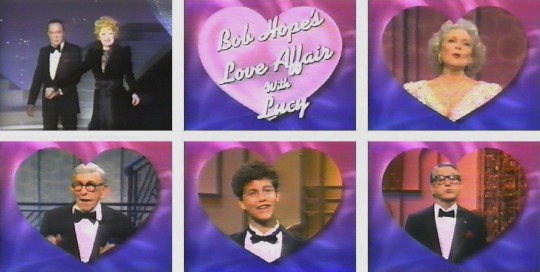
This
special aired on a Saturday evening at 10pm, traditionally a
difficult time for television programs. Luckily, its lead-in was the
season 5 premiere of the phenomenally successful “The Golden Girls”
(also featuring Betty White) which led the evening with a 23.5 share.
“Bob Hope’s Love Affair With Lucy” came in second, with a
respectable 19.3. It was up against College Football on ABC. Because
the special was 90 minutes and started on the half hour, its
competition on CBS was the last half hour of “Tour of Duty”
(season 3 premiere) and the series premiere of “Saturday Night With
Connie Chung.”
Because
this special aired on NBC, no scenes from any of Lucille Ball’s CBS
sitcoms (or “Life with Lucy” on ABC) were included. Kirk Cameron
was an ABC star, but worked on several of Hope’s NBC specials.
Although Betty White never acted with Lucille Ball, the pair enjoyed
an off-stage friendship. White also was a perfect tie-in to keep
“The Golden Girls” fans tuned after the sitcom’s season opener.
Although Burns and Thomas both worked on screen with Lucy, no clips
of their collaborations were used. Also conspicuously missing is
Gale Gordon, who was part of Lucille Ball’s career since her days on
radio.
[For more information about the clips, click on the hyperlinks, where available.]
BOB HOPE

The
special opens with a montage of clips of Lucille Ball’s entrances on
Bob Hope’s specials, underscored by the “I Love Lucy Theme.”
After a quick commercial break, Bob
Hope
enters to the sounds of his theme song “Thanks for the Memory.”
Hope:
“Lucy
handled the media and television like she handled everything else,
with grace and style and a richness of color that didn’t need any
help from the peacock.”
The
‘peacock’ Hope is referring to is the NBC logo. Lucille Ball left CBS
for NBC in 1980, but the move resulted in only one TV special (“Lucy
Moves To NBC”), one failed pilot (“Bungle Abbey”) and multiple
appearances on Bob Hope’s specials.

The
first clip in the 90-minute tribute is from “The
Bob Hope Christmas Special”
(December 9, 1973). Ball and Hope play themselves in a sketch about a
misunderstanding surrounding an expensive ring he’s bought for his
wife, but sent to Lucy’s home for safe keeping. Naturally,
Lucy thinks it’s for her. The clip features appearances by long-time
Lucy character actress Doris Singleton and Lucy’s husband Gary
Morton.
DANNY
THOMAS

Danny
Thomas calls Lucy his ‘landlady’ because “Make Room for Daddy”
was shot at Desilu Studios. He tells a funny anecdote from when Ball
appeared on his short-lived sitcom “The Practice” in 1976.
Thomas:
“When
I worked on her show, she did most of the directing. And when she did
my show… she did most of the directing.”
Thomas
talks about of their working relationship. He says that despite their
great friendship, Lucy would not divulge her age, even to him.
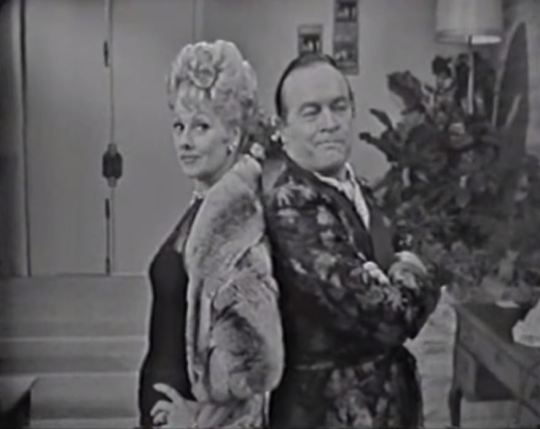
In a voice over, Bob Hope introduces a black and white clip
of a sketch from “The
Bob Hope Show” (October
24, 1962). In it Lucy plays a District Attorney and Bob a gangster
named Bugsy Hope. The 1962 clip edits out a bit that was
frighteningly prescient. A spray of gunfire comes through the window
and Lucy remarks “Just
what I wanted, a Jackie Kennedy hairdo.”
Considering the tragic events of November 1963, this clearly could
not be aired in 1989. Another change involves music royalties: in
the original, Lucy makes her entrance into Bugsy’s flat to the tune of
David Rose’s “The Stripper” (released in 1962) but in 1989 it is
replace by a similar sounding piece of music.
Bugsy
Hope:
“I
don’t usually go for flatfeet, but the rest of you kind of makes up
for it.”
DA
Lucy: “I
don’t usually go for hoods, but you could use one.”
In
the sketch, Hope makes Lucy laugh and drop character several times, a
rarity for Ball.
KIRK
CAMERON
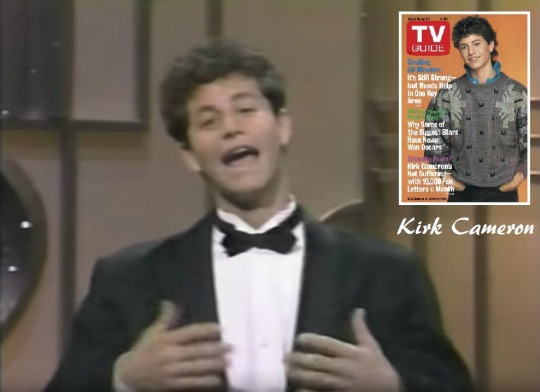
Kirk
Cameron (who had just turned 18) says that the first time he met
Lucille Ball on a May 1987 Bob Hope show at an Pope Air Force Base in
North Carolina. On a subsequent Hope special, Lucy needed a stand-in
to take a pie in the face and chose Cameron. He was unsure if it was
an honor or payback for making her wait outside her dressing room to
meet him the year before.
Cameron:
“I think that I speak for a lot of people my age when I say that I
love Lucy.”


The
next clip is the satire of “I Love Lucy” featuring the entire
original cast (plus Hope and Tommy the trained seal). In “The
Bob Hope Chevy Show” (October
6, 1956), Hope introduces the sketch as himself wondering what it
would be like if he had married Lucy instead of Desi. It is presented
in its original black and white, although it was later colorized for
a video release. Not coincidentally, five days earlier the sixth and
final season of “I Love Lucy” began airing with “Lucy and Bob
Hope” (S6;E1).
GEORGE
BURNS

George
Burns affectionately recalls how Lucy was in show business 24 hours a
day. He says that he was married to a comedienne (Gracie Fields) but she couldn’t have been more different than Lucy.
Burns:
“Lucy was all of show business wrapped up in this charming lady.”
He
remembers an appearance with Lucy when they sang “Lazy”
by Irving Berlin. He sings a few bars. Burns says that he’s booked to
play the Palladium in London when he turns 100. Although he did live
to 100, his health declined at age 98 and this booking never came to
pass.

Bob’s
voice over introduces a couple of scenes from The
Facts of Life,
a black and white film that Hope and Ball did for United Artists in
1960. In the scene Larry (Hope) and Kitty (Lucy) are on a fishing
boat remembering old times when they realized they went to the same
high school together. In the second clip, Kitty and Larry realize
they can’t play cards without their glasses, but they can’t kiss with
them on either. Finally, Larry and Kitty are kissing at the drive-in
when they are spotted by the local dry cleaner. Lucy had just
finished playing Lucy Ricardo, with the final episode of “The
Lucy-Desi Comedy Hour” airing in April 1960.
BETTY
WHITE
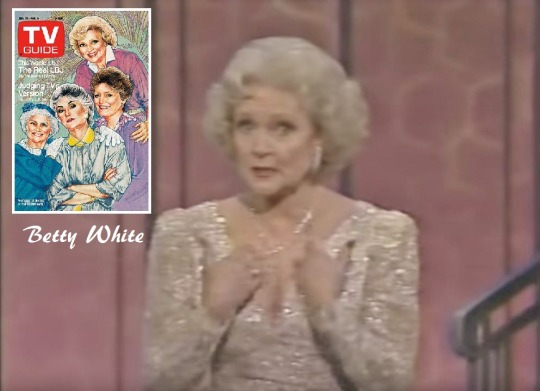
To
the accompaniment of “Thank You for Being a Friend” Golden Girl
Betty White is introduced. She lists three-word TV titles of the
’50s, “Our Miss Brooks,” “I Married Joan,” “Life with
Elizabeth,” “Father Knows Best,” and “I Love Lucy.” White
remembers that she shot her second series “Date With the Angels”
at Desilu Studios and that is where she first met Lucy.
White:
“I
can still see her. Tall and built and she had a navy blue dress on
with white polka dots and this hair that made it look like her head
was on fire.”
White
credits Lucille Ball with filming comedy using the three camera
system and a studio audience. White’s mother Tess and Lucy’s mother
Dede were great friends. Betty recalls the last time she saw Lucy, a
week before she went into the hospital. She says she can still recall
Lucy’s deep and abundant laughter that night. White let’s the
audience know that they shoot “The Golden Girls” at the old
Desilu lot.

Bob’s
voice introduces a clip from the film
Fancy Pants (1950)
with Bob Hope as Humphrey the butler and Lucy as Agatha, the daughter
of the man he works for. This movie was made just before Lucille
Ball got pregnant with her daughter Lucie, and before “I Love Lucy”
was in development. At the time, Ball was starring on radio in “My
Favorite Husband.”

Next is a dramatic scene from
Sorrowful Jones,
a film Hope and Ball did in 1949. Ball played Gladys and Hope was
Sorrowful (aka Humphrey).

A
clip from “Happy
Birthday, Bob: 50 Stars Salute Your 50 Years with NBC”
(May 16, 1988) has Lucy singing
“Comedy Ain’t No Joke”
by Cy Coleman and James Lipton.
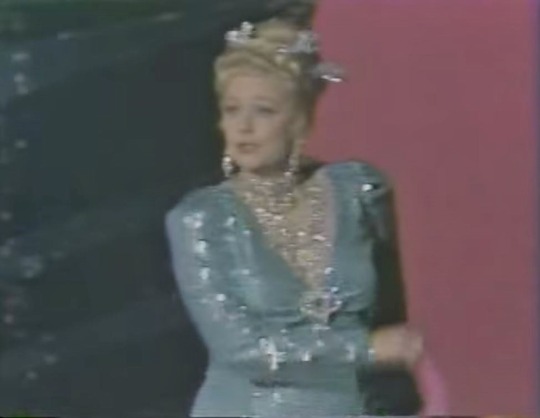
This leads directly into Lucy as
Sophie Tucker singing “Some
of These Days” from
“Bob
Hope’s All Star Comedy Tribute to Vaudeville”
(May 25, 1977).
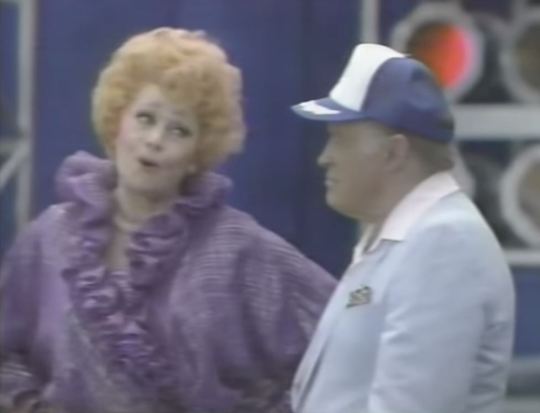
Lucy
and Bob sing “I
Remember It Well”
by Frederick Loewe from “Bob
Hope’s High-Flying Birthday Extravaganza”
(May 25, 1987). The song (originally from the film Gigi)
has special lyrics with references to their legendary partnership including
Fancy
Pants
and Facts
of Life.

Finally,
a clip of Lucy and Bob’s last appearance together at the
61st Annual Academy Awards telecast (March
29, 1989). This was also Lucille Ball’s last public appearance.

In his final remarks, Hope works in mentions of two of Lucy’s most
memorable comedy bits from “I Love Lucy”: “Hollywood at Last!”
(S4;E16) and “Lucy’s Italian Movie” (S5;E23).
Hope:
“Whether
her nose caught fire or she was stomping grapes, Lucy got us all to
laugh. Thanks Lucille, for making life a ball.”
The
closing credits appear over stills of Lucy and Bob on TV, some of
which were not included in the special.
This
Date in Lucy History – September 23rd

“Mod,
Mod Lucy”
(HL S1;E1) – September 23, 1974
Leave a comment